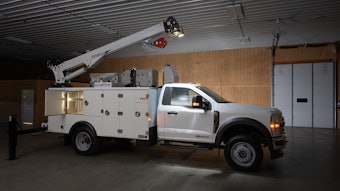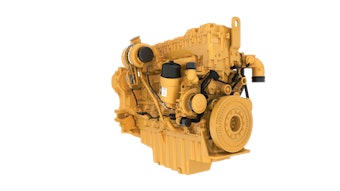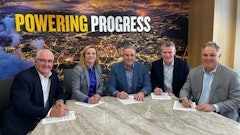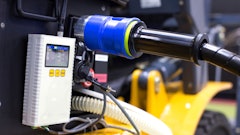
Last week, the U.S. Department of Energy’s SuperTruck project broke another record in efficiency for Class 8 tractor-trailer truck efficiency. While the original SuperTruck goal was to improve freight efficiency by 50% compared to a 2009-model baseline vehicle, Daimler Trucks North America (DTNA) announced that its Freightliner SuperTruck vehicle achieved a 115% freight efficiency improvement, measured in ton-miles/gallon. The Freightliner Supertruck achieves 12.2 miles per gallon (mpg).
Increasing the efficiency of Class 8 trucks is essential because they haul 80% of the goods in the U.S. and use about 20% of the fuel consumed in transportation. The Department of Energy’s Vehicle Technologies Office (VTO) established the SuperTruck program in 2009 to explore how teams of truck manufacturers and suppliers could design and optimize various high-efficiency technologies in a single system. In addition to overall increases in freight efficiency, VTO set a goal of a 50% improvement in engine efficiency, which DTNA also met.
DTNA achieved this efficiency breakthrough by using a spectrum of technologies including a downsized and downsped 10.7-liter engine, highly engineered aerodynamic surfaces, wide-based low-rolling resistance tires, a long-haul hybrid system, and engine waste heat recovery. A Detroit D12 Automated Manual Transmission was augmented with Direct Drive and eCoast technologies to gain efficiency. Many of the technologies build on VTO's research in a number of areas such as advanced combustion engines, lightweight materials, and parasitic loss reduction.
To measure freight efficiency, DTNA ran vehicle testing on highway routes in Oregon and Texas, one city route in Portland, Ore., and anti-idle testing in both a cold chamber and hot chamber. These tests resulted in the combined 115% freight efficiency improvement.
Testing was also conducted at the DTNA Detroit engineering facility to demonstrate engine efficiency by achieving 50.2% engine brake thermal efficiency.
The final SuperTruck demonstrator ran a five-day, 312-mile round trip route on Texas Interstate 35 between San Antonio and Dallas, at a weight of 65,000 lbs. GVWR at a speed of 65 mph, where it achieved an average result of 12.2 mpg.
“It is our expectation that we will continue to review and refine what we’ve learned and achieved over the course of the SuperTruck initiative, and use that knowledge to bolster our leadership in fuel efficiency,” said Derek Rotz, principal investigator for SuperTruck, Daimler Trucks North America.
Several commercially viable technologies developed in conjunction with the SuperTruck program have been introduced in DTNA production vehicles, including 6x2 optimization and the aerodynamic components found on the Freightliner Cascadia Evolution and the integrated Detroit Powertrain.
Strategies such as downspeeding with a custom engine rating and using the predictive capabilities of Intelligent Powertrain Management (IPM) components such as pre-loaded 3D digital maps to control shifting and eCoast events also increased efficiency and economy.
“By incorporating a mix of available technologies with future innovations, we were able to use the SuperTruck program to take the first steps in seeing what may be technically possible and commercially viable,” said Rotz. “We still have a long road ahead to determine ultimately what will be successful and what will achieve the greatest efficiencies.”
One key initiative was exploring how the tractor and trailer should be designed and optimized as a single system, not separate units. DTNA engineers also examined the impact and opportunities for efficiency gains with tire partners.
Features such as energy-efficient, wide-based, low-rolling resistance single tires and highly engineered aerodynamic surfaces on the trailer also maximized efficiency.
“We took a clean-sheet approach and looked beyond just the vehicle and engine,” noted Rotz. “We examined and analyzed and tested every single angle on the truck and trailer in our quest to achieve the best results.”
During the development of the SuperTruck, DTNA engineers investigated how high-risk, high-reward technologies used in other industries could be applied to Class 8 vehicles. Electrified auxiliaries, controlled power steering and air systems, active aerodynamics, a long-haul hybrid system, waste heat recovery and trailer solar panels were some of the items assessed.
“Part of our process included taking a deep dive into different systems to analyze not only what might be possible, but obstacles as well,” explained Rotz.
Freightliner’s SuperTruck team discovered that some of these components, due to regulatory or economic barriers, may not be commercially viable in the near future.
DTNA was actually the second SuperTruck team to exceed the SuperTruck goal. In 2014, Cummins and Peterbuilt unveiled their SuperTruck, which demonstrated a 76% increase in freight efficiency. VTO is also working with Navistar and Volvo, which are on separate project schedules, both on track to meet the SuperTruck goal. VTO chose all four teams through a competitive process. The industry partners are matching VTO funding.
Sponsored by the U.S. Department of Energy (DOE), the SuperTruck program was a five-year research and development initiative to improve freight efficiency by at least 50%, brake thermal efficiency by 50%, and reduce fuel consumption and greenhouse gas emissions of Class 8 trucks. DTNA and three other major truck OEMs were awarded multi-million dollar grants by the DOE and each matched the DOE funding dollar for dollar. SuperTruck is supported by the U.S. DOE under the American Recovery and Reinvestment Act of 2009.

![[VIDEO] Volvo Trucks Introduces It'ing the SuperTruck Concept Vehicle](https://img.forconstructionpros.com/files/base/acbm/fcp/image/2016/09/default.57ebe85f3c83d.png?auto=format%2Ccompress&fit=crop&h=75&q=70&w=75)

























